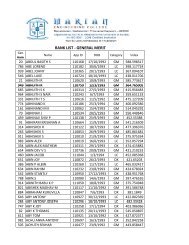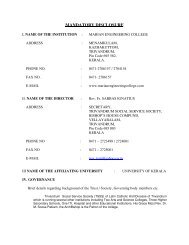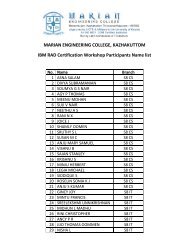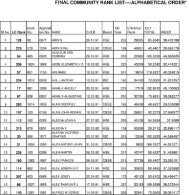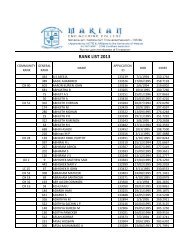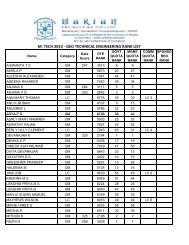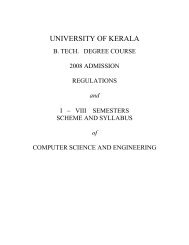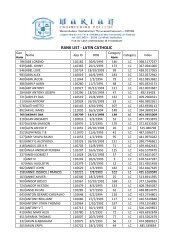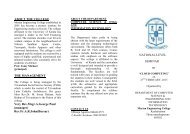UNIVERSITY OF KERALA - College of Engineering, Trivandrum
UNIVERSITY OF KERALA - College of Engineering, Trivandrum
UNIVERSITY OF KERALA - College of Engineering, Trivandrum
You also want an ePaper? Increase the reach of your titles
YUMPU automatically turns print PDFs into web optimized ePapers that Google loves.
08.606.3 ElectiveII WAVE HYDRODYNAMICS<br />
L T P/D Cr<br />
3 1 0 4<br />
Module I<br />
Review <strong>of</strong> fundamental principles and its relative significance – (no questions to be asked). Classification <strong>of</strong><br />
ocean waves, Definition <strong>of</strong> wave parameters (wave length, period, Celerity). Regular and irregular waves.<br />
Linear Wave theory (Airy’s theory)-Assumptions- Boundary Conditions, solution <strong>of</strong> Laplace equation with<br />
Boundary Conditions - Derivation <strong>of</strong> wave surface pr<strong>of</strong>ile, wave length, wave celerity, orbital motion <strong>of</strong> water<br />
particles and orbital displacement <strong>of</strong> water particles in shallow water condition, transitional water condition and<br />
deep water conditions-related problems.<br />
Module II<br />
Wave kinematics, pressure field under wave system, wave energy, Energy propagation (Energy flux or wave<br />
power), group velocity in deep and shallow water conditions-related problems.<br />
Wave Transformations- Shoaling, refraction – refraction patterns on different bed configurations- problems<br />
considering shoaling and refraction effects, wave reflection wave diffraction, wave breaking in deep water,<br />
transitional water and shallow water, types <strong>of</strong> breakers.<br />
Module III<br />
Finite amplitude theory-Stokes theory, Trochoidal theory and solitary wave theory, Region <strong>of</strong> validity <strong>of</strong> various<br />
theories.<br />
Wave loads on vertical walls and Caissons - Sainflou method (problems) - Brief study <strong>of</strong> Minikin Method and<br />
Goda's method (Problems not required).<br />
Wave measuring techniques-pressure wave gauge, Rider buoys, Wave direction measuring techniques.<br />
References:<br />
1. Turgut Sarpkaya & Michael Issacson , Mechanics <strong>of</strong> Wave forces on <strong>of</strong>fshore structures , Van<br />
Nostrand Reinhold Company, 1981<br />
2. Robert G. Dean & Darlymole, Water wave mechanics for engineers and scientists, Prentice Hall<br />
Publishers-New Jersey<br />
3. A.T.Ippen ,Estuary & Coastline hydrodynamics, Mc Graw Hill publication<br />
4. U.S Army Corps <strong>of</strong> Engineers, Shore protection manual (Vol. I &. II),1984 Coastal <strong>Engineering</strong><br />
Research Centre<br />
5. Robert M Sorenson, Basic Coastal <strong>Engineering</strong>, Springer,2005<br />
6. Harbour and Coastal <strong>Engineering</strong>-NIOT Chennai<br />
7. S.K Chakrabarthi ,Hydrodynamics <strong>of</strong> <strong>of</strong>fshore structures, Computational Mechanics<br />
Publications,1987<br />
8. U.S Army Corps <strong>of</strong> Engineers, Coastal <strong>Engineering</strong> Manual, 2006, U.S Army Engineer Research<br />
and Development Centre.<br />
9. Baba M and Kurian N.P (ed), Ocean Wave Mechanics for Engineers and Scientists, Allied<br />
publishers Ltd<br />
Question Paper:<br />
Duration: 3 hours<br />
The question paper consists <strong>of</strong> Part A and Part B.<br />
Part A is for 40 marks. There will be 8 compulsory short answer questions <strong>of</strong> 5 marks each covering entire<br />
syllabus.<br />
Part B is for 60 marks. There will be two questions from each module. The candidate has to answer one<br />
question <strong>of</strong> 20 marks from each module.<br />
Note: No charts, tables, codes are permitted in the Examination hall .If necessary the same shall be given along<br />
with the question paper by the question paper setter<br />
61



